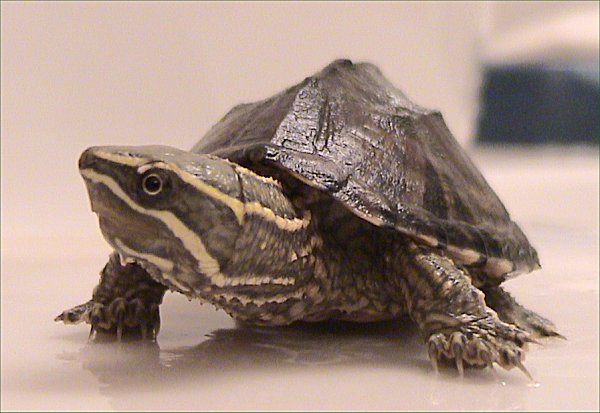|
| Query: john edward gray | Result: 2nd of 29 | |
Common Musk Turtle (Sternotherus odoratus) - Wiki
| Subject: | Common Musk Turtle (Sternotherus odoratus) - Wiki
| |

| Resolution: 600x413
File Size: 50735 Bytes
Upload Date: 2007:10:10 12:58:47
|
Sternotherus odoratus
From Wikipedia, the free encyclopedia
[Photo] Common Musk Turtle (Sternotherus odoratus). Photographer: User:Dawson (http://en.wikipedia.org/wiki/User:Dawson)
The Common Musk Turtle or Stinkpot (Sternotherus odoratus) is a species of small turtle native to southeastern Canada and most of the eastern half of the United States, named after their ability to release a foul musky odor to deter predation. They are sometimes bred specifically to be kept as pets.
Description
Stinkpots are a black, grey or brown turtle with a highly domed shell. They grow to approximately 4 inches (10 cm) in length. They have long necks and rather short legs. Males can usually be distinguished from females by their significantly longer tails. Their heads are vaguely triangular in shape, with a pointed snout and sharp beak, and yellow-green striping from the tip of their nose to their neck. Algae often grows on their carapace.
Behaviour
Musk turtles are almost entirely aquatic, spending the vast majority of their time in shallow, heavily vegetated waters of slow moving creeks, or in ponds. They typically only venture onto land when the female lays her eggs, or in some rare cases, to bask.
Diet
They are carnivorous, consuming a wide variety of aquatic invertebrates, including crayfish, freshwater clams, snails, and various insects. They will also eat fish and carrion. Their common names are derived from the scent glands located just under the rear of their shell, which allows them to release a foul musky odor to deter predation. Wild turtles often will not hesitate to bite if harassed, though they are not particularly fast-moving and their reach is limited.
Reproduction
Breeding occurs in the spring, and females lay 2 to 9 elliptical, hard-shelled eggs in a shallow burrow or under shoreline debris. The eggs hatch in late summer or early fall. Hatchlings are usually less than one inch long. Their lifespan, as with most turtles, is quite long, with specimens in captivity being recorded at 50+ years of age.
Geographic distribution
The Common Musk Turtle ranges in Canada in southern Ontario, southern Quebec, and in the United States from southern Maine in the north, south through to Florida, and west to central Texas, with a disjunct population located in central Wisconsin.
Taxonomy
The species was first described by the French taxonomist Pierre Andr?? Latreille in 1802, from a specimen collected near Charleston, South Carolina. At the time, almost all turtles were classified in the genus Testudo, and he gave it the name Testudo odorata. In 1825, John Edward Gray created the genus Sternotherus to include species of musk turtle and it became Sternotherus odoratus. The species has been redescribed numerous times by many authors, leading to a large amount of confusion in its classification. To confuse it further, the differences between mud turtles and musk turtles are a point of debate, with some researchers considering them the same genus, Kinosternon.
Conservation status
Though the Common Musk Turtle holds no federal conservation status in the US and is quite common throughout most of its range, it is listed as a threatened species in the state of Iowa.
In captivity
Due to its small size, the Common Musk Turtle generally makes a better choice for a pet turtle than other commonly available species, such as the Red-eared Slider (Trachemys scripta elegans). Throughout their range wild-caught specimens are commonly available, but the species is also frequently captive-bred specifically for the pet trade. They readily accept a diet of commercially available turtle pellets and various insects, such as crickets and mealworms, or earthworms. Due to their almost entirely aquatic nature, the Common Musk Turtle also does not necessarily require the UV lighting that most other turtle species do for proper captive care, though it is usually recommended to give them a more natural light cycle than normal indoor lighting.
http://en.wikipedia.org/wiki/Sternotherus_odoratus
| The text in this page is based on the copyrighted Wikipedia article shown in above URL. It is used under the GNU Free Documentation License. You may redistribute it, verbatim or modified, providing that you comply with the terms of the GFDL. |
|
Comments |
|---|
| | billig cialis |
|
| cNmZWB ekypjibp adssetcp khvmujgt |
| | cialis verde |
|
| sttbtnwx vuxdbmks iqwfszrs |
^o^
Animal Pictures Archive for smart phones
^o^
|
|
|